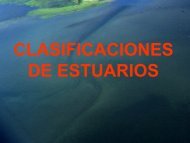Chapter 6 - Tidal Courses: Classification, Origin and Functionality
Chapter 6 - Tidal Courses: Classification, Origin and Functionality
Chapter 6 - Tidal Courses: Classification, Origin and Functionality
Create successful ePaper yourself
Turn your PDF publications into a flip-book with our unique Google optimized e-Paper software.
Author's personal copy<br />
206 Gerardo M.E. Perillo<br />
continental drainage but also in the form of rain which, when intense, also produces<br />
strong surface sediment erosion (Mwamba <strong>and</strong> Torres, 2002) which when conducted<br />
by the geomorphology can easily erode the sediment surface further <strong>and</strong> generate or<br />
prolong tidal courses. Then, further evolution of these features becomes a tidal process.<br />
7. SUMMARY<br />
<strong>Tidal</strong> courses are an essential part of coastal wetl<strong>and</strong>s as they play a major role<br />
in water <strong>and</strong> nutrient exchange. However, their origin <strong>and</strong> evolution is still a<br />
matter of discussion due to the complexities of the dynamic processes associated<br />
with their initiation. Some factors such as the role of overl<strong>and</strong> flows versus bankfull<br />
flow in the evolution of the courses are unknown. A major question is what<br />
actually controls course me<strong>and</strong>ering on tidal flats. Contradictory examples about<br />
the me<strong>and</strong>ering distribution can be given when the cases of the Anse d’Aiguillion<br />
(Eisma, 1997) <strong>and</strong> Bahía Blanca Estuary are compared. In the former, creeks in the<br />
higher flats are strongly me<strong>and</strong>ering <strong>and</strong> become straight <strong>and</strong> sinuous in the low<br />
flats, whereas in Bahía Blanca Estuary, what occurs is exactly the opposite; sinuosity<br />
increases significantly for creeks <strong>and</strong> gullies along the margins of tidal channel while<br />
on the surface of the flats they are much less sinuous.<br />
A tidal course classification has been proposed to establish a unified description<br />
of these features <strong>and</strong> to avoid confusion. Based on geomorphologic information,<br />
this classification may evolve further by integrating other descriptors. Therefore,<br />
this classification is open to consideration <strong>and</strong> discussion.<br />
ACKNOWLEDGMENTS<br />
Partial funding for researches that lead to the present review was provided by<br />
CONICET, Agencia de Promoción Cientifica y Tecnológica <strong>and</strong> Universidad<br />
Nacional del Sur of Argentina <strong>and</strong> the National Geographic Society of USA.<br />
This chapter is also a contribution to the SCOR-LOICZ-IAPSO WG<br />
122 “Mechanism of Sediment Retention in Estuaries.” I thank the constructive<br />
comments by Eric Wolanski.<br />
REFERENCES<br />
Adamowicz, S.C., Roman, C.T., 2005. New Engl<strong>and</strong> salt marsh pools: a quantitative analysis of<br />
geomorphic <strong>and</strong> geographic features. Wetl<strong>and</strong>s 25, 279–288.<br />
Ahnert, F., 1960. Estuarine me<strong>and</strong>ers in the Chesapeake Bay Area. Geogr. Rev. 50, 390–401.<br />
Allen, J.R.L., 2000. Morphodynamics of Holocene salt marshes: a review sketch from the Atlantic<br />
<strong>and</strong> Southern North Sea coasts of Europe. Quat. Sci. Rev. 19, 1155–1231.<br />
Ashley, G.M., Zeff, M.L., 1988. <strong>Tidal</strong> channel classification for a low mesotidal salt marsh. Mar. Geol.<br />
82, 17–32.




